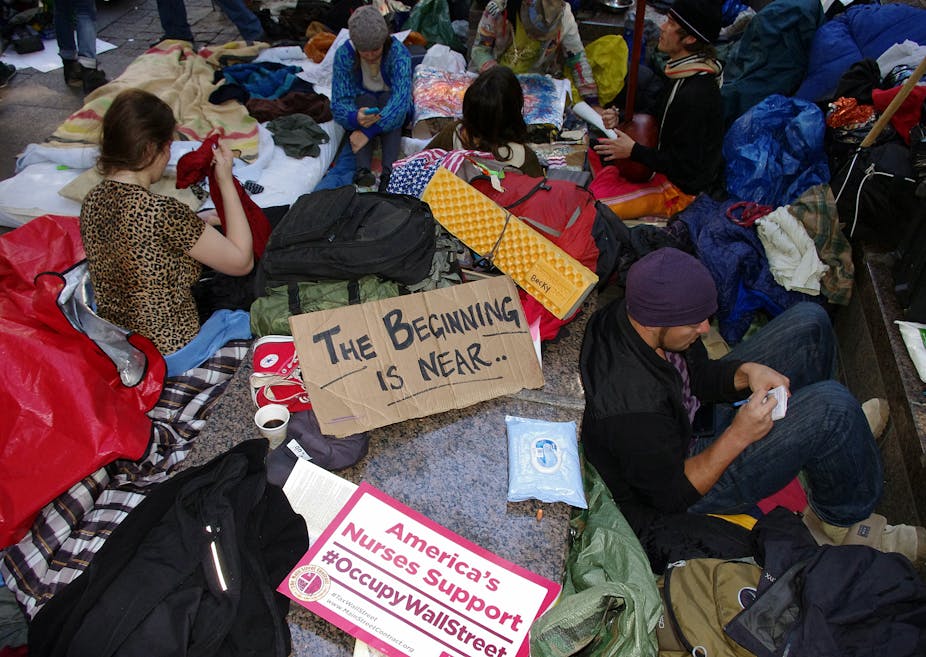In a media environment weary of big events and relentless political and social upheaval, creative activism emotionally re-engages bystanders with the protest movements that – sometimes inspiring, sometimes irritating – can persist for months.
Activists are increasingly using creative strategies for advancing their work in new and surprising ways. Think 2010’s Arab Spring, the global Occupy movement, and most recently Hong Kong’s Umbrella Revolution.
Emerging forms of hybrid online/ offline creativity and permutations of creative communities are changing the ways activists and social movements do their jobs.
The People’s Puppets are a branch of the Occupy movement that continue to expand their creative reach post-2011 and the disbanding of Zucotti Park. Groups such as the People’s Puppets and Occupy Museums are using a combination of both digital and old-school craft strategies to reach new audiences, maintain communities, promote anti-capitalist values, and work toward tangible social change.

What does this hybrid approach offer creative artists, activists and their publics?
In my current study with Occupy and digital media expert Megan Boler, we focus on the synergies of creativity, pedagogy, and activism.
Our study also considers the socio-spatial aspects of creative activism: from in-the-street actions to web-based communication networks and digital connectivity. Specifically, we celebrate how activists offer DIY strategies to those wishing to become creative activists wherever and whenever they desire by accessing easy-to-use resources such as the Creative Activists’ Tool Kit.
The US-based Center for Creative Activism documents researches these same questions, documenting hybrid coalition-building and serving as a virtual hub for creative protest community-building.
Our study shows that young people today are integrating their civic engagements through community-based and creativity-based collectives and practices. They move easily across and through local/global and online/offline contexts. For the participants of these grass-roots social movements, concerns about capitalism, education, climate, and political engagement cannot be separated.
Invisible labour
Acknowledging the links between art and activism is not new.
Feminist and performance studies scholars have long noted the public pedagogical function of creativity, activism and the arts. Yet this new creative activism seeks to define creativity against a backdrop of a “networked creative class” that remains exclusionary to the localised, non-networked, and technology-poor.

In the widening gap between the networked and non-networked, what is the social role of creativity? If the pervasive definition of creativity has been flattened toward “innovation” and digitality, can the kind of local craft-based creativity that the Peoples’ Puppeteers deploy be considered “invisible creative labour”?
Enter the need for online/ offline hybridity, and what some creative activists call the scalability of an anti-capitalist social movements.
Author and activist Naomi Klein explored these ideas in her recent book This Changes Everything (2014), in which she critiques the “creative capitalism of philanthropist billionaires”.
Klein has long noted the links between capitalism and climate change. As a leader of the massive Peoples’ Climate March in New York City in September 2014, Klein has given voice to the kinds of integrated activism that many young people today see as necessary to affecting lasting structural social change.
Like Klein, much current scholarship notes that digital media is powered by a range of invisible creativities. One powerful example is the Occupy Museums campaign against the building of the Guggenheim in Abu Dhabi, in which the invisible and undervalued local labour of the guest-worker builders are subsumed into global “creative industries” discourses and institutional artworld media campaigns.
Social change is necessarily creative

Nearly 80 years ago, in 1936, cultural theorist Walter Benjamin noted that a new form of “reproducibility” (through film and photography) was changing the social function of art in his day.
In 2015, we are seeing similar seismic shifts in the functions and forms of creativity and its social role precipitated by technological change.
Through using handmade puppets to charm and seduce opponents, The People’s Puppeteers make activist labour both more visible and invisible. Unlike traditional activist marchers, the bulk of their time commitment is spent in the DIY making culture to which they belong.
Carrying the puppets in street actions becomes a performance of fun and belonging that causes some outsiders, including cops and children, to want to join these merry bands of pranksters. Our research shows that this public relation is significantly different from earlier waves of direct action, with massively different effects.
The People’s Puppets of Occupy and other similar activist nodes are truly digitally and spatially hybrid communities of practice. The labour of creating social change today is inherently digital, global, local and imaginative. Creative activist communities embody a new kind of civic engagement that has much to offer citizens from all walks of life.
Read other articles in our Creativity series here.

